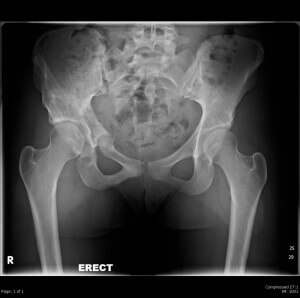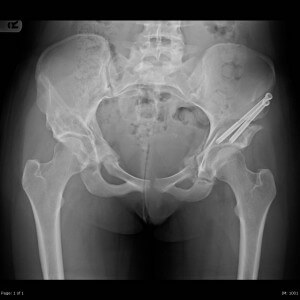Periacetabular OsteotomyThis is used for treating a shallow hip socket in children aged 10 onwards and into adulthood. This operation is frequently performed because of painful symptoms in the hip.
The operation involves making cuts around the hip socket so the hip socket can be rotated into a better position. The procedure is performed under a general anaesthetic. An incision is made in the groin to divide the bones. The rotated socket is held in place with screws, which are buried beneath the skin. In older children and adults, there is no need for a body plaster (hip spica). The operation requires a hospital stay of 5-7 days.  We encourage you to sit up, move the leg and stand with crutches as soon as possible. At discharge from hospital, you are able to walk with crutches. You will be given exercises to rehabilitate the hip.
What happens after I go home? The crutches are required for a minimum of 6 weeks to protect your hip. We often arrange for you to come back into hospital for a week on rehabilitation. This involves exercises and using the hydrotherapy pool. Return to work depends on the nature of your work and your rate of recovery.
Complications There is a small risk of injuring nerves and blood vessels around the hip. The most common complication is to be left with a numb patch around the side of the thigh. There is a small chance of injuring the sciatic nerve which can result in weakness and numbness in the foot. There is a small change of damage to the hip joint. If the bone cuts are slow to heal (non union), then further surgery can be required. Blood clots (DVT) can occur after this surgery but are uncommon. Measures are taken to reduce this risk. Any operation for pain may not relieve the pain. There is a chance of pain becoming worse after the operation. This can happen if complications occur during or after surgery, and if the hip becomes arthritic over time. The procedure can restrict full flexion of the hip. Further surgical procedures can be required if complications occur. A further small operation is required to remove the screws 6-12 months after the surgery. What can I do to Prepare for the operation? 1. Stop smoking- smoking increases risks after surgery and can inhibit bone healing 2. Get fit. Patients who are fit before surgery recover better afterwards. Although your hip is painful, you can still exercise, such as swimming, gym, cross trainer etc. exercise will make your muscles stronger and help you to lose weight. 3. Lose weight. Losing weight is good for your health, and makes hip symptoms less and improves recovery from surgery. 4. Positive outlook. This will help you to get up, go home and mobilise more quickly. 5. Home adaptations. Are there any home adaptations that you can make before surgery? Moving a bed downstairs, bath seat etc |

